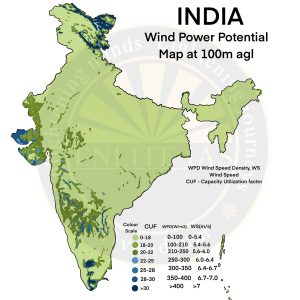- How does it work?
- Wind energy uses air movement to generate electricity via wind turbines.
- Converts kinetic energy into mechanical energy and then into electrical energy.
- Global Contribution
- Major players: Germany, USA, Denmark, Spain, and India (80% of global capacity).
- India ranks 4th globally with a capacity of 39.25 GW (March 2021).
- Types of Wind Farms
- Onshore Wind Farms: Located on land, cost-effective, but face physical obstructions and noise/visual impact.
- Offshore Wind Farms: Located at sea, higher efficiency, larger turbines, but expensive to install/maintain.
- India’s Wind Energy
- Potential: 302 GW (100m hub height).
- Key States: Tamil Nadu, Gujarat, Karnataka, Maharashtra, Rajasthan, Andhra Pradesh, Madhya Pradesh.
- Targets: 5 GW offshore by 2022, 30 GW by 2030.
- Largest Wind Farms in India
- Muppandal Wind Farm (Tamil Nadu): 1500 MW.
- Jaisalmer Wind Park (Rajasthan): 1064 MW.
- Advantages
- Clean, renewable energy source.
- Offshore farms offer higher wind speeds and more energy generation.
- Quick installation for onshore turbines compared to other energy sources.
- Challenges
- Onshore: Visual and noise pollution, inconsistent wind speeds.
- Offshore: High costs, limited skilled workforce, lack of incentives, marine ecosystem concerns.
- Policy and financial hurdles like discom inefficiencies, delayed payments.

